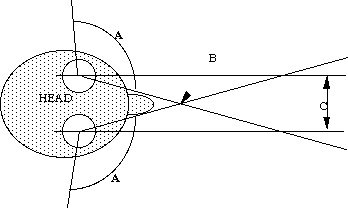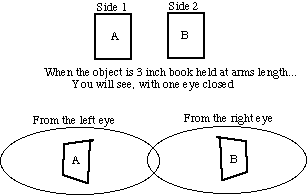

In this figure, A equals the angle of the eye to see images and motion (motion only at high acute and obtuse angles), B equals the point at which the nose interferes with the eyes ability to see images and motion, and C equals the distance between the centerline of the eyes' lens. This tiny offset, C, causes the location of the image in the field of view for that eye, A in the left eye, for example, to be different than the same image in the right eye Look at the figure below to see how the eyes each view the same image (object) differently.

This effect adds to the depth perception information the brain needs to derive an image with three dimensions. Combining these images makes a three-dimensional image.
From this small offset in focal centerlines, there are problems as well. Some of these will become apparent when designing virtual space with objects that are certain varying distances. The human vision system only supports this stereoscopic depth perception for objects that are between approximately 8 inches and 18 feet. Beyond that, the vision system uses other cues to detect depth and distance. To explore one of the phenomenon of stereoscopic vision systems, use the following figure to find your own blind spot. Hold the figure at arm's length. Close the left eye and focus of the circle/cross. Move the figure slowly towards you. Notice the spot disappear as the figure gets closer. This is your blind spot.

At greater distances, the eyes can detect very subtle movements and changes in spatial relationship between objects. These changes are the primary source of information in the distance and depth perception cues for viewing in excess of 18 feet.
Surface properties such as luster, scintillation, and sheen are difference in luminance and color between the left and right retinal images, and cannot be seen in single image. Surface inspection and analysis, or similar tasks may require a stereoscopic image.
With stereoscopic vision, the brain can more easily seperate a correlated image from static and dynamic visual interference(noise). When there is poor image quality due to interference such as low resolution, limited grey scale, motion blurr, and raster noise, binocular vision diminishes the influence of the noise.
The brain is not being stressed to extract a three dimensional comprehension from two dimensional input. Offering stereo displays reduces a perceptual workload.
Note that these advantages are additive; stereoacuity is the cumulative result of all dimensional depth cues.